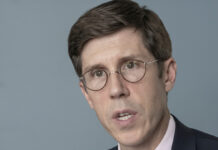WASHINGTON – The U.S. economy may end 2011 growing at its fastest clip in 18 months as analysts increase their forecasts for the fourth quarter just a few months after a slowdown raised concern among investors.
Economists at JPMorgan Chase & Co. in New York now see gross domestic product rising 3 percent in the final quarter, up from a previous prediction of 2.5 percent. Macroeconomic Advisers in St. Louis increased its forecast to 3.2 percent from 2.9 percent at the start of November, while New York-based Morgan Stanley & Co. boosted its outlook to 3.5 percent from 3 percent.
“The incoming data on consumption, business spending and residential investment all point to GDP growth in the fourth quarter tracking 3.3 percent,” said John Herrmann, senior fixed-income strategist at State Street Global Markets in Boston.
Herrmann, who is the second most-accurate forecaster of GDP based on Bloomberg data, had been looking for fourth quarter growth of 2.4 percent at the start of this month. The economy expanded at an annualized pace of 2.5 percent in the third quarter.
Joseph LaVorgna, chief U.S. economist at Deutsche Bank Securities in New York, said he wouldn’t be surprised to see fourth-quarter growth of 4 percent, though for now he is sticking with his forecast of 3 percent.
Strengthening Economy
The strengthening economy will help lift U.S. stock prices, which have been depressed by the sovereign debt crisis in Europe, LaVorgna said.
Futures on the Standard & Poor’s 500 Index expiring in December rose 0.8 percent to 1,225 at 7:54 a.m. in New York. The benchmark Stoxx Europe 600 Index gained 0.1 percent to 234.23 at 12:34 p.m. in London. The yield on the 10-year Treasury note rose to 2 percent from 1.96 percent late Thursday.
“There’s too much pessimism built into the market,” he said, adding that the Standard & Poor’s 500 Index could break 1,300 by year’s end. The stock gauge closed at 1,216.13 Thursday.
The economic pick-up also may push up yields on Treasury securities, Herrmann said. The yield on the 10-year note could rise to 2.25 percent or higher in the first quarter of next year, he said, assuming Europe avoids a financial catastrophe akin to the 2008 bankruptcy of Lehman Brothers Holdings Inc. The 10-year yield stood at 1.96 percent at 5 p.m. New York time Thursday, according to Bloomberg Bond Trader prices.
Consumer Spending
Behind the revised fourth quarter forecasts: Consumers have not cut back on spending even with the turmoil in world financial markets, putting pressure on companies to rebuild inventories they ran down because of concerns about Europe.
Helped by the biggest jump in electronics purchases in two years, retail sales rose 0.5 percent in October, after a 1.1 percent increase the month before, according to the Commerce Department.
“We feel confident that the momentum we have heading into the fourth quarter, combined with our holiday strategies, bode well for that quarter,” said Karen Hoguet, chief financial officer for Cincinnati-based Macy’s Inc., the second-biggest U.S. department-store chain. “We’ll have a spectacular Christmas,” she added on a Nov. 9 conference call with analysts.
Companies, meanwhile, held their inventories little changed in September as sales climbed, the Commerce Department reported on Nov. 15. Businesses had enough goods on hand to last 1.27 months at September’s sales pace, near the record low of 1.24 months reached earlier this year.
Manage Inventories
Retailers “continue to manage their inventories very carefully,” Harlan Kent, CEO of Yankee Candle Co. Inc., which sells its products to retailers like Macy’s and Target Corp., said on a Nov. 10 call with investors. “We are in good shape to quickly respond to replenishment orders and capitalize on any uptick in consumer demand.”
Restocking will boost growth by 0.8 percentage points in the fourth quarter, according to JPMorgan Chase. In the third quarter, inventory changes reduced GDP by 1.1 percentage points. The economic outlook beyond the fourth quarter rests heavily on what policy makers do, both in Europe and the U.S., said Michael Feroli, JPMorgan Chase’s chief U.S. economist.
The U.S. would not be able to “escape the consequences of a blowup in Europe,” Federal Reserve Chairman Ben S. Bernanke said in El Paso, Texas on Nov. 10. “The world’s financial markets are highly interconnected.”
Fed’s Dudley
Federal Reserve Bank of New York President William C. Dudley said in a speech Thursday that while recent economic reports have shown improvement, that shouldn’t be a signal for the Fed to relax its efforts to boost the economy. Growth next year may be around 2.75 percent after somewhat more than 2.5 percent in the fourth quarter, he said.
“Although the latest news on the U.S. economy is somewhat more encouraging than that from earlier in the year, we should not take much solace from that,” he said. “The U.S. economy continues to face several obstacles,” including consumers cutting debt and caution by businesses.
“We also continue to face significant downside risks, mostly related to the stress in the euro zone,” Dudley said.
Financial Crisis
Euro-region policy makers are struggling to contain a financial crisis that started two years ago in Greece and which has now spread to Italy, the region’s third-biggest economy with a debt of 1.9 trillion euros ($2.6 trillion).
In Washington, the focus has been on the deliberations of the Congressional supercommittee, which faces a Nov. 23 deadline to come up with measures to reduce the budget deficit by $1.2 trillion over 10 years.
What’s more important for the economy in 2012 though is the fate of a number of stimulus measures, including a 2 percent cut in employee payroll taxes and extended unemployment benefits, that are due to expire at end year, Feroli said.
If Congress doesn’t continue them, “the drag from tightening fiscal policy could subtract 1.5 to 2 percentage points from GDP growth next year,” the former Fed economist added in Nov. 10 note to clients.
Households would be particularly hit, as the payroll tax cut and extended unemployment benefits boosted their income by about $150 billion this year, according to Feroli.
Holiday Season
For now, consumer spending has been holding up as the crucial end-of-year holiday selling season gets underway.
The rise in retail sales last month prompted economists David Greenlaw and Ted Wieseman at Morgan Stanley to bump up their forecast for growth of household outlays in the fourth quarter to 2.7 percent from 2.2 percent. Personal consumption expenditures rose at an annualized rate of 2.4 percent in the third quarter, the fastest pace so far this year.
Economists are divided over what’s behind the buoyancy of spending. David Rosenberg, chief economist at Gluskin Sheff & Associates in Toronto, ties it to a fall in the savings rate that they argue can’t last. That rate dropped to 3.6 percent in September, the lowest level since the start of the last recession in December 2007.
Often Revised
Others like LaVorgna play down the significance of the drop in the savings rate, noting that it is a statistic that is frequently revised.
Feroli, too, cautioned against reading too much into the savings numbers and pointed to other reasons for the resilience of consumer expenditures.
Ebbing inflation is giving households more spending power. Consumer prices fell in October for the first time in four months, dropping 0.1 percent after a 0.3 percent rise in September, the Labor Department said on Nov. 16. Contributing to the fall was a 3.1 percent decline in gasoline prices.
Lower borrowing costs, courtesy of a flight into Treasury securities by investors fearful of developments in Europe and the Fed’s continued easy monetary policy, are also helping households. The average rate for a 30-year fixed rate mortgage was 4 percent in the week ended Nov. 17, barely above the 3.94 percent record low hit last month, according to Freddie Mac.
Construction Permits
Housing construction permits climbed last month to their highest level since March 2010, according to Commerce Department data, as the near record-low mortgage rates lured some buyers into the market.
The future pace of consumer spending ultimately will be decided by the growth of household income, which in turn is tied to the health of the job market.
And there, Herrmann saw some reason to be optimistic. He forecast that private-sector payrolls would rise an average 160,000 per month for the rest of this year and by 200,000 per month in the first four months of 2012. Private payrolls increased 104,000 in October.
In a sign that the job market may be improving, claims for unemployment benefits dropped to their lowest level in seven months in the week ended Nov. 12, to 388,000, Labor Department figures released yesterday showed.
“With Europe an albatross around our necks, the fact that the economy is firming and performing better than expected is really encouraging,” said Omair Sharif, an economist at RBS Securities Inc. in Stamford, Conn.












